The global textile market is an intricate ecosystem consisting of the production, processing, and distribution of fibers, fabrics, and finished textile goods used across multiple sectors such as fashion, home furnishings, automotive, healthcare, and industrial uses. Driven by technological advancements, shifting consumer preferences, and global economic trends, the textile market has experienced remarkable expansion and diversification. Key segments include apparel, home textiles, and technical textiles with each serving different purposes and requirements.
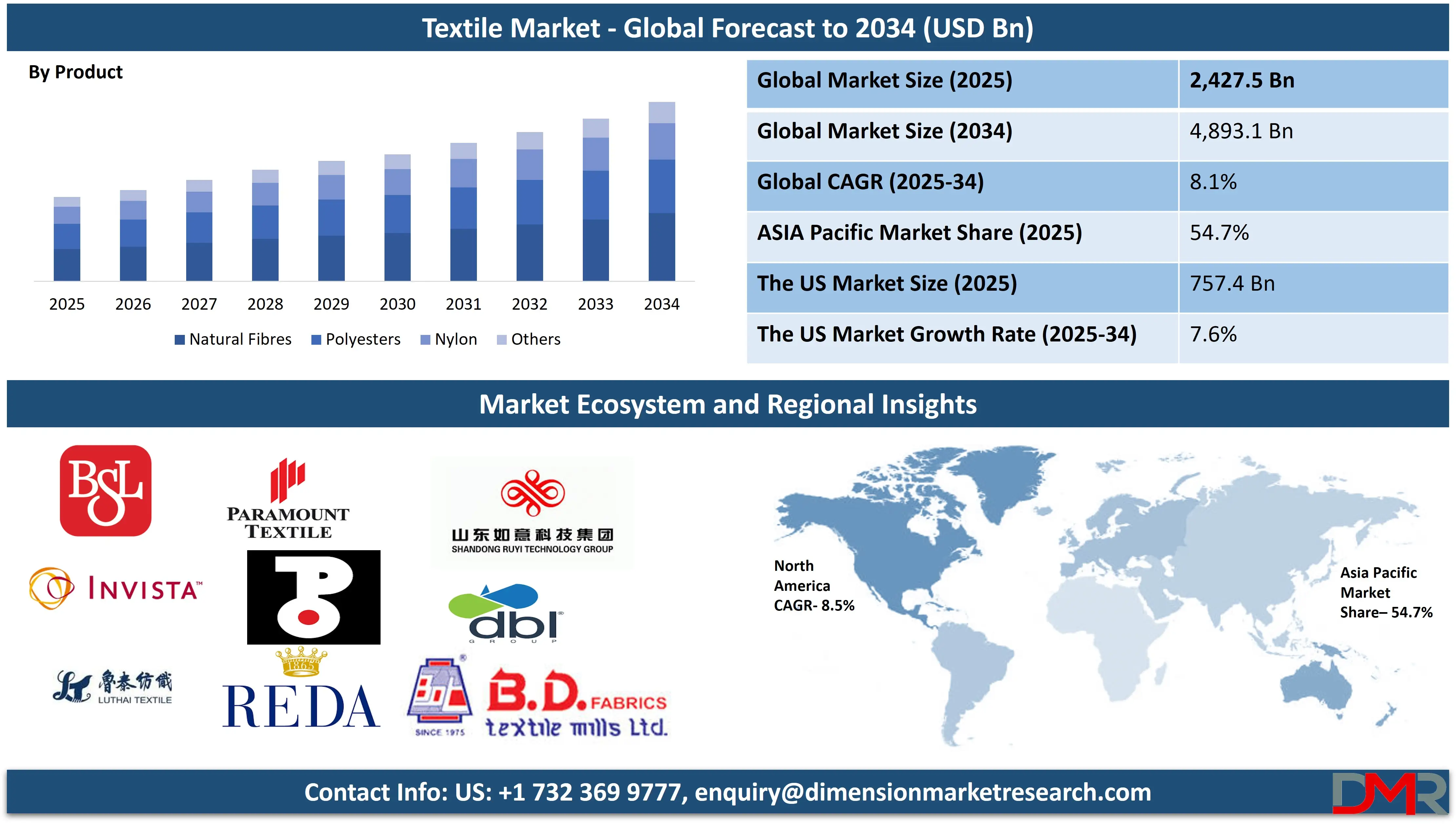
The global textile market is poised for sustained and transformative growth and transformation due to technological innovations, sustainability initiatives, and consumer preferences that continue to change over time. Industry forecasts point towards strong expansion as markets adapt to global trends and economic developments.
Consumers and regulatory bodies have placed more importance on carbon footprint reduction, ethical sourcing, and waste management. These factors are expected to lead to greater adoption of recycled fibers, organic materials, and biodegradable fabrics, creating new opportunities for innovation and collaboration along with technologies like blockchain which may increase supply chain transparency while upholding compliance with environmental standards. Technological innovation will play a pivotal role in shaping our future. Integrating artificial intelligence (AI), IoT, and robotics into textile production will increase efficiency, customization, and cost-effectiveness.
Additionally, the rise of e-commerce and digital platforms has transformed how textiles are marketed and distributed, allowing manufacturers and retailers to reach a broader audience while providing personalized shopping experiences. These platforms enable faster response to shifting fashion trends and consumer demands, fostering a more agile and competitive marketplace. Emerging markets in Asia-Pacific, Africa, and Latin America are also playing a crucial role in driving the global textile market's growth, fueled by increasing disposable incomes, urbanization, and a growing middle class.
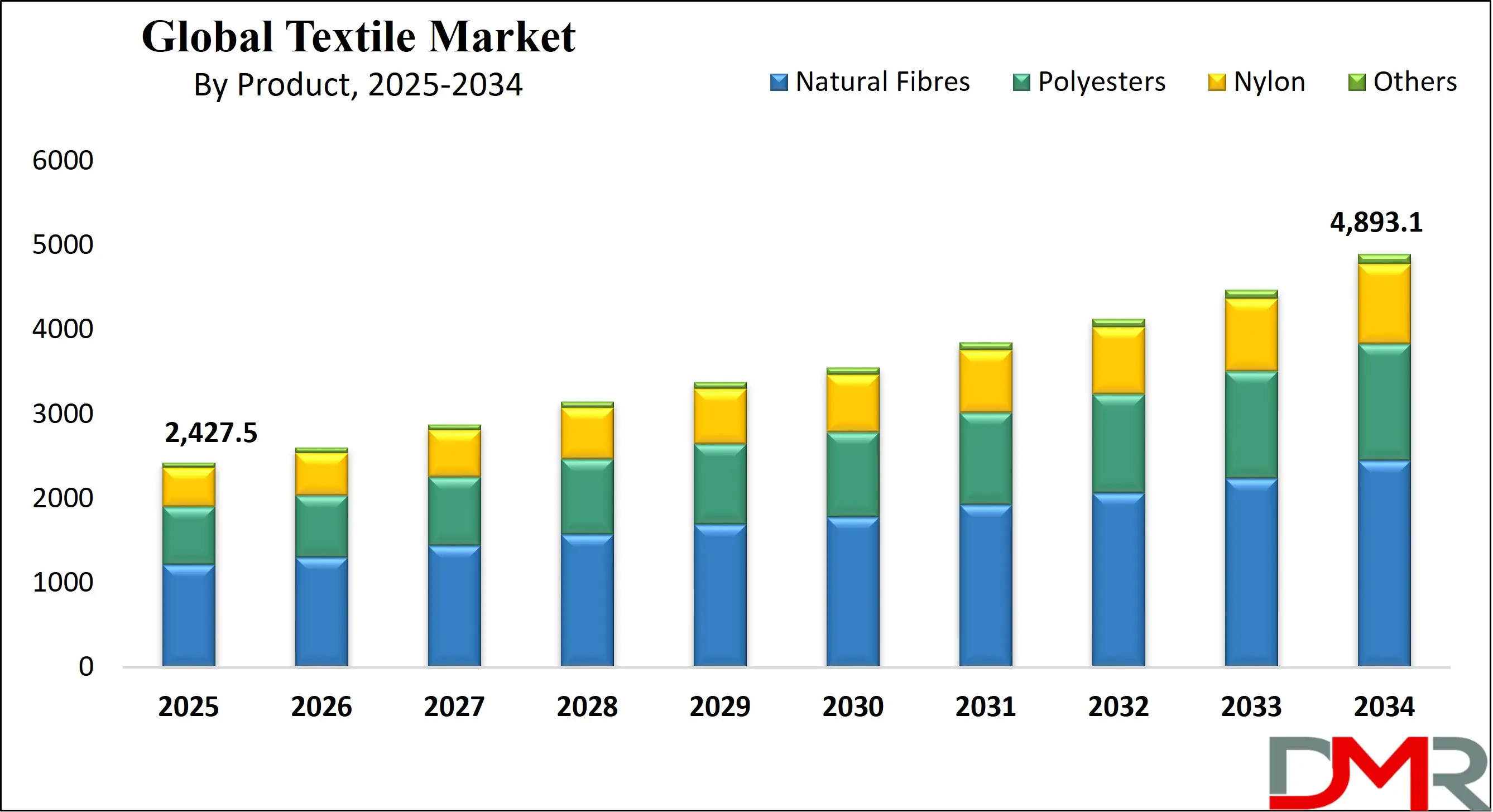
As the industry evolves, partnerships between governments, manufacturers, and technology providers will be essential in addressing challenges such as supply chain disruptions, resource scarcity, and the growing demand for sustainable practices. Together, these trends are paving the way for a more innovative, inclusive, and environmentally responsible textile industry.
The US Textile Market
The US Textile Market is projected to be valued at USD 757.4 billion in 2025. It is expected to witness subsequent growth in the upcoming period as it holds USD 1,465.3 billion in 2035 at a CAGR of 7.6%.
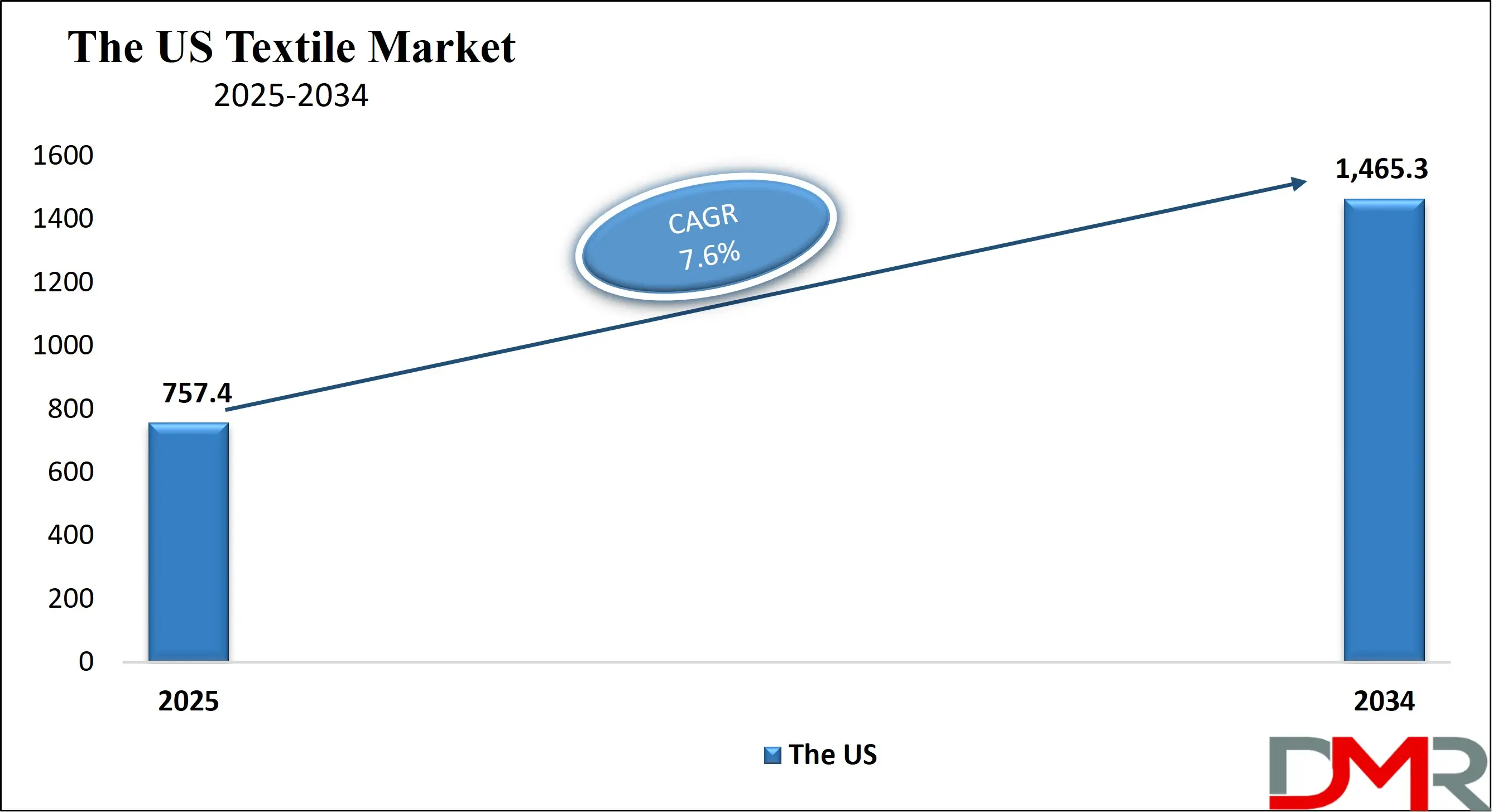
The US textile market is an integral component of global textile production, distinguished by its focus on innovation, high-quality production, sustainable practices, and localized production. While traditional textile production in the US has declined in recent decades due to outsourcing and cost pressures, other specialized areas like technical textiles, nonwovens, and sustainable fabric production remain strong pillars for growth within this sector.
Consumer preferences for eco-friendly and sustainable products are revolutionizing the market, with US brands increasingly turning to recycled fibers, organic cotton, and biodegradable materials to meet regulatory standards and consumer expectations. Reshoring trends have also gained steam, with companies investing in local manufacturing to reduce supply chain risks and ensure faster delivery times.
Localization will play an integral part in shaping the market's growth, with government initiatives and incentives providing incentives for domestic production. The US may expand its technical textile segment due to rising demand from industries like automotive, aerospace, and construction. Furthermore, digitalization and consumer demand for customized products continue to drive consumer preferences, positioning this industry perfectly to adapt and thrive within an increasingly globalized landscape.
Global Textile Market: Key Takeaways
- Market Value: The global textile market size is expected to reach a value of USD 4,893.1 billion by 2035 from a base value of USD 2,427.5 billion in 2025 at a CAGR of 8.1%.
- By Raw Material Segment Analysis: Cotton is projected to maintain its dominance in the raw material type segment, capturing 40.0% of the market share in 2025.
- By Product Segment Analysis: Natural Fibers are anticipated to capture the global textile market with 50.0% of the market share in the product segment by 2025.
- By Application Segment Analysis: Household Applications are poised to maintain its dominance in the application type segment capturing 70.0% of the total market share in 2025.
- By Region Analysis: Asia-Pacific is anticipated to lead the global textile landscape with 54.7% of total global market revenue and it is further anticipated to maintain its dominance by 2025.
- Key Players: Some major key players in the global textile market are, BSL Limited, INVISTA S.R.L, Lu Thai Textile Co. Ltd., Paramount Textile Limited, Paulo de Oliveria, and Other Key Players.
Global Textile Market: Use Cases
- Smart Textiles in Healthcare: Smart textiles, embedded with sensors and advanced materials, are revolutionizing the healthcare industry. These fabrics monitor vital signs, track patient health, and provide therapeutic benefits. For example, wearable garments with integrated sensors can monitor heart rate, blood pressure, and body temperature in real-time, assisting in early diagnosis and continuous patient care.
- Sustainable Apparel Production: The global shift toward sustainability has transformed the fashion and apparel sector. Brands are increasingly adopting recycled fibers, organic cotton, and biodegradable fabrics to create eco-friendly clothing. Initiatives like circular fashion, where garments are designed for recycling and reuse, are gaining traction.
- Technical Textiles in Construction and Infrastructure: Technical textiles are extensively used in construction and infrastructure projects for their durability and functionality. Geotextiles, for instance, reinforce soil in road construction, prevent erosion, and improve drainage. Fire-resistant and waterproof fabrics are used in building materials to enhance safety and longevity.
- E-Commerce and Digital Customization in Fashion: The rise of e-commerce platforms has expanded access to customized and made-to-order textiles and apparel. Digital tools allow consumers to select fabrics, patterns, and designs tailored to their preferences. Technologies like 3D printing and AI-driven design recommendations enhance this personalization.
Global Textile Market: Stats & Facts
- According to the National Library of Medicine (NLM), Textile production is the world’s second most polluting industry second to the oil industry accounting for approximately 1.2 billion tons of greenhouse gas emissions.
- As per the National Library of Medicine (NLM), the world consumes about 80 billion new clothing every year.
- According to the National Library of Medicine (NLM), It is estimated that around 98% of all future fibers will be synthetic, 95% of which is expected to be polyester.
Market Dynamic
Global Textile Market: Driving Factors
Sustainability and Eco-Friendly PracticesSustainability has emerged as a driving factor for global textile markets, altering how they operate and respond to environmental challenges. As more awareness has grown about the textile sector's significant environmental footprint including high water consumption, greenhouse gas emissions, and waste generation eco-friendly practices have become even more crucial to success. Consumers, governments, and industry stakeholders all play an essential role in driving an increase in focus on sustainability. Consumer demand for ethically produced, eco-friendly products has never been greater, with many consumers prioritizing brands that incorporate recycled materials, organic fibers, and sustainable manufacturing processes into their product designs.
The introduction of circular economy initiatives has contributed significantly to this movement, encouraging the reuse and recycling of materials to extend product lifespans while decreasing landfill waste. Take-back programs and clothing collections designed to reduce resource depletion are increasingly being implemented by industry players as part of an overall effort to conserve natural resources. Technological advances have played an essential role, with innovations like bio-based fibers from agricultural by-products and ocean plastics providing more sustainable alternatives.
Technological Advancements
Technological developments have emerged as one of the main forces shaping the global textile market, helping producers meet consumer expectations for quality, efficiency, and innovation. Tech is revolutionizing every aspect of manufacturing, from automated production processes and smart textiles to digital design tools. Automation and robotics have greatly enhanced production efficiency while decreasing labor costs and manufacturing errors. Modern machinery allows companies to take advantage of faster production cycles, keeping up with the demanding needs of industries like fashion and technical textiles. Smart textiles with sensors and advanced materials are finding a wide range of uses across healthcare, sports, and defense environments, including temperature regulation, health monitoring, and improved durability features.
Innovative production technologies like waterless dyeing, 3D weaving, and bioengineering are helping address sustainability concerns by decreasing resource consumption and waste production. Technology is revolutionizing the textile market, but it poses significant challenges, including capital investment requirements and the skill development necessary to manage complex systems. Despite these obstacles, cutting-edge technology continues to fuel textile industry growth, enhance competitiveness, and open new possibilities. By adopting innovation-based approaches in their operations, global textile markets not only increase productivity and profitability but also create sustainable long-term strategies.
Global Textile Market: Restraints
High Environmental Impact and Regulatory Pressures
One of the major obstacles facing global textile market growth is its environmental impact and increasing regulatory requirements to address it. Textile production consumes a large volume of water, energy, and chemicals that contribute to pollution and ecological degradation. Processes like dyeing and finishing generate high volumes of wastewater with hazardous substances while synthetic fibers like polyester lead to microplastic pollution in oceans and waterways. As governments and international organizations respond to environmental concerns, governments have issued stringent regulations intended to reduce the industry's ecological impact. Policies related to carbon emissions, water usage, chemical management, and waste disposal have become more common.
For instance, REACH in Europe and ZDHC's program for Zero Discharge of Hazardous Chemicals require significant investments into green production methods and cleaner technologies, making meeting these regulatory requirements financially straining especially for small and medium-sized enterprises (SMEs) without sufficient resources for change implementation.
Volatile Raw Material Prices
Volatile raw material prices present a serious threat to the global textile market. Cotton, wool, polyester, and other synthetic fiber costs can fluctuate due to factors like supply chain disruptions, climate conditions, geopolitical tensions, and global economic factors, with natural fiber prices such as cotton particularly vulnerable when conditions such as droughts or floods alter weather patterns, leading to crop shortages that ultimately drive prices higher. Synthetic fibers made from petroleum-based products may also experience fluctuations in oil prices.
Price fluctuations of raw materials further complicate efforts to implement sustainable practices. Eco-friendly materials like organic cotton or recycled fibers tend to have higher upfront costs than their conventional counterparts, making it challenging to offer these sustainable options without affecting profit margins or disrupting profits. Financial uncertainty could discourage businesses from adopting more eco-friendly or high-quality materials thereby hampering their responsiveness to changing consumer tastes and regulatory pressures.
Global Textile Market: Opportunities
Growth in the Technical Textiles Market
Technical textiles represent one of the greatest opportunities in the global textile market, as these fabrics are engineered for specific functional purposes beyond clothing. Technical textiles have found widespread application across various industries including healthcare, automotive, aerospace, construction agriculture, and defense, providing considerable room for market expansion. Technical textiles provide enhanced properties like durability, flexibility, moisture resistance fire resistance, and electrical conductivity that make them suitable for niche applications.
Antimicrobial textiles have found their use as medical devices, wound dressings, and hygiene products due to their antibacterial properties. Wearable health-monitoring textiles have grown popular for real-time tracking of vital signs. Technical textiles with superior strength-to-weight characteristics have found applications such as interior materials, airbags, seat belts, and composite components contributing to vehicle safety and performance.
Expansion of Sustainable and Eco-Friendly Textile Innovations
As global demand for eco-friendly products increases, textile markets offer significant opportunities. Consumers and brands majorly prioritize environmental responsibility. Accordingly, there has been an upsurge in sustainable materials, ethical production processes, and innovations aimed at reducing waste and pollution. This movement does not just involve fashion, rather it stretches across applications that span home textiles, industrial textiles, technical textiles, etc.
Biodegradable textiles and plant-based alternatives to synthetic fibers (which typically rely on petroleum sources) are becoming mainstream as an eco-conscious consumer trend. Textile manufacturers that invest in these innovations can capitalize on this consumer preference and regulatory pressure to adopt sustainable practices to lower carbon footprints.
As brands embrace sustainability, they can not only set themselves apart in the marketplace but also align themselves with international initiatives for environmental conservation. Furthermore, sustainable textiles have the potential to open up markets in emerging economies where demand is increasing for eco-friendly solutions.
Global Textile Market: Trends
Rise of Digital and On-Demand Textile Production
One key trend transforming the global textile market is digital and on-demand textile production. As consumer preferences evolve toward personalized and custom products, mass production models are being replaced by agile, efficient, and flexible production processes involving digital technologies like 3D knitting, direct-to-garment (DTG) printing, and fabric design software that enables on-demand production creating less wasteful inventory by manufacturing only when necessary.
Artificial Intelligence (AI), machine learning, and data analytics technologies further support this trend, enabling manufacturers to predict consumer demand more precisely while optimizing production schedules. Consumers increasingly desire unique products such as custom-fit clothing or unique patterns and designs that resonate with them as individuality is increasingly prized over exclusivity in purchases.
Increasing Adoption of Automation and AI in Textile Manufacturing
As labor costs increase and consumer demands for faster production times and higher-quality products increase, textile manufacturers are switching towards advanced technologies like robotics, AI, and machine learning to streamline their operations and enhance manufacturing efficiency and precision. Automation technology helps minimize human error while increasing consistency, speeding production cycles to meet tight deadlines, and meeting stringent quality standards.
AI-powered systems are being employed for predictive maintenance, supply chain optimization, and quality control in manufacturing plants, helping reduce downtime and costly defects. Furthermore, smart factories with interconnected machines that collect real-time data to make decisions regarding production adjustments, inventory management, and demand forecasting create an agile and responsive production environment.
Automation and AI are revolutionizing the design process in addition to increasing efficiency. Computer-aided design (CAD) software, 3D knitting technology, and digital printing enable designers to explore complex patterns quickly with reduced prototyping costs; further responding to consumer demand for unique textile products.
Global Textile Market: Research Scope and Analysis
By Raw Material
Cotton is projected to maintain its dominance in the raw material type segment, capturing 40.0% of the market share in 2025. Cotton's longstanding dominance can be attributed to its versatile properties, making it suitable for multiple industries and applications. Cotton fibers have long been valued for producing clothing, home textiles, and medical products due to their softness, breathability, and durability. Cotton's versatile qualities have long made it the go-to fabric for apparel such as shirts, jeans, and undergarments as well as bedding, towels, and household textiles. Cotton can be found in both lightweight fabrics and heavyweight materials to meet various consumer market’s needs.
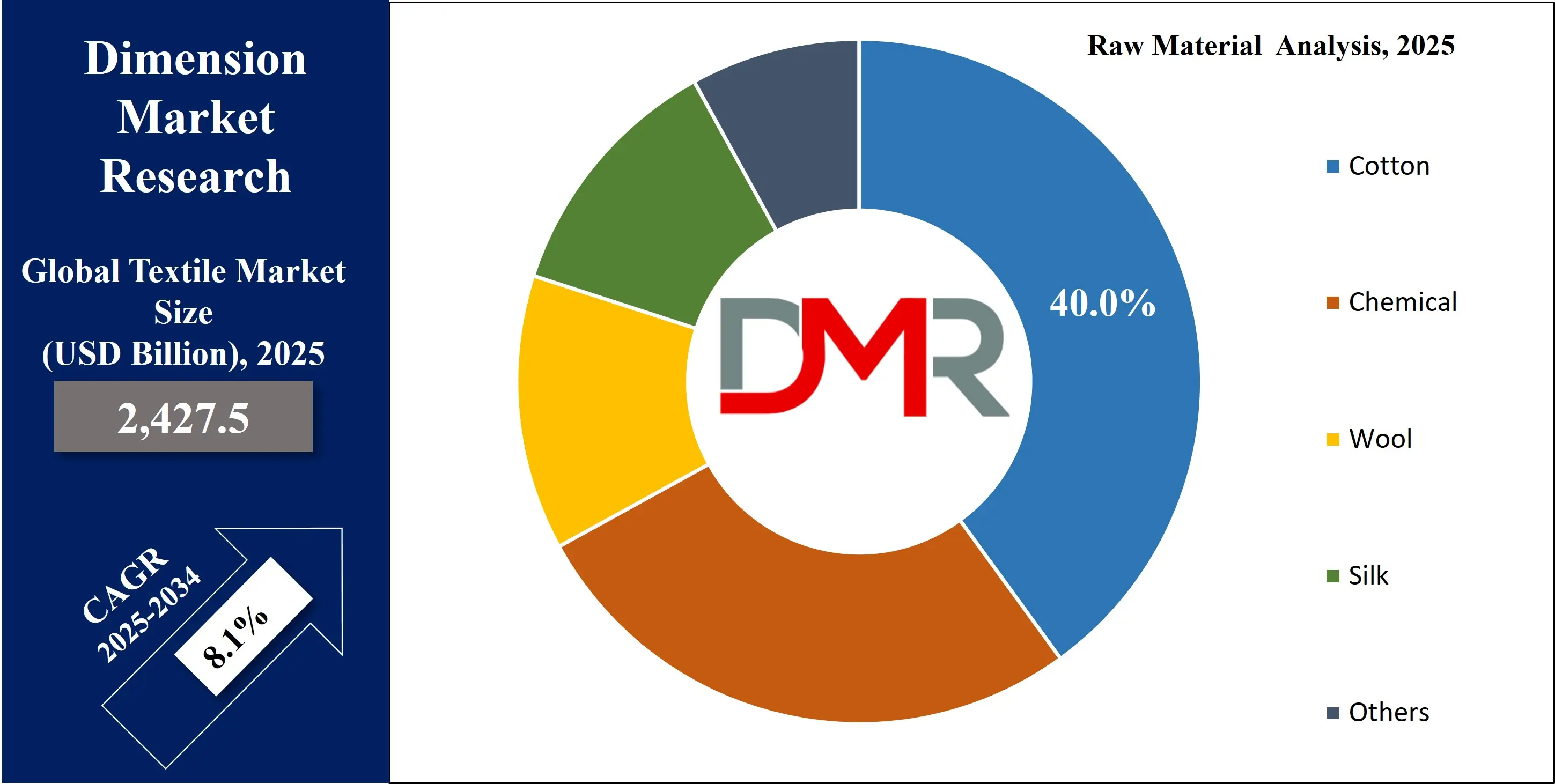
Cotton remains an eco-friendly material of choice in textile production as sustainability gains ground. Organic cotton, produced without harmful chemicals, is becoming more and more desirable among consumers who prioritize eco-friendly products. Cotton's environmental friendliness only strengthens its position in the textile market, as it biodegrades quickly compared with synthetic fibers which take much longer to break down. With growing consumer interest in sustainably and circularly, its renewable and biodegradable nature gives cotton an obvious edge, further cementing its place as the dominant global textile player.
As consumer demand for eco-friendly products grows, the cotton industry is adapting by increasing its focus on sustainable practices. Initiatives like organic cotton farming and certifications such as Fair Trade and Better Cotton Initiative (BCI) are gaining traction, aligning with the broader global trend toward sustainability. While challenges such as water usage and land management persist, cotton's strong position in the textile market remains unchallenged due to its cost-effectiveness, comfort, and adaptability.
By Product
Natural Fibers are anticipated to capture 50.0% of the global textile market share in the application segment in 2025. Their dominance can be attributed to their unique qualities of comfort, breathability, and biodegradability which appeal directly to consumer preferences for high-quality and eco-conscious textile products such as cotton, wool, silk, jute, hemp, and flax. These materials are known for their variety of usage including apparel, home textiles, industrial applications as well as aesthetic attributes while aligning themselves with a global emphasis on sustainability and eco-conscious practices globally.
In the context of sustainability, the textile industry is primarily adopting natural fibers in response to the growing pressure to reduce carbon footprints, water usage, and chemical dependence. Natural fibers also align with circular economy models, as they can be recycled or composted at the end of their lifecycle. With these benefits, natural fibers are positioned to hold a dominant share of the textile market, especially as companies focus on transparency, ethical sourcing, and minimizing their environmental impact.
The rising demand for natural fibers can be attributed to increased consumer awareness about the environmental impact of synthetic fibers, which are derived from petroleum-based materials and contribute to microplastic pollution. Natural fibers, being biodegradable and renewable, offer a more environmentally friendly alternative, making them a preferred choice for consumers and brands committed to reducing their ecological footprint. The adoption of organic farming practices and certifications for natural fibers, such as organic cotton and ethical wool, further boosts their appeal by providing transparency and assurance about sustainable production processes.
By Application
Household Applications are poised to maintain its dominance in the application type segment capturing 70.0% of the total market share in 2025. This significant contribution can be attributed to household applications' consistent use, such as bedding, curtains, upholstery, towels, and carpets. They form the backbone of household consumption while providing stable revenue streams for textile producers. Rising global population numbers, increasing urbanization levels, growing disposable incomes in emerging economies as well as an aging population all drive demand for high-quality and aesthetically pleasing home textile products that also promote wellness in households globally.
The household textiles segment is also benefiting from shifting consumer preferences for comfort, sustainability, and style. Consumers are mainly opting for eco-friendly, organic, and high-quality materials in household items. This is pushing manufacturers to innovate with sustainable fabrics, such as organic cotton, bamboo, and linen, while also meeting aesthetic demands with a variety of designs, colors, and textures. Additionally, the rise of e-commerce platforms has made household textiles more accessible to a global consumer base, further fueling market growth.
Modern homes prioritize comfort, style, and functionality - leading to greater demand for innovative textile solutions that combine comfort, style, and functionality with aesthetics. Consumers seek textiles that not only meet practical needs but also enhance the overall appearance and feel of their living space. As such, premium home textile products such as luxury bedding made of Egyptian cotton or silk, designer curtains, and high thread-count sheets have seen increasing interest from those searching for both utility and elegance in one product.
The Global Textile Market Report is segmented on the basis of the following
By Raw Material
- Cotton
- Chemical
- Wool
- Silk
- Others
By Product
- Natural Fibers
- Polyesters
- Nylon
- Others
By Application
- Household
- Bedding
- Kitchen
- Upholstery
- Towel
- Others
- Technical
- Construction
- Transport
- Medical
- Protective
- Fashion & Clothing
- Apparel
- Ties & Clothing Accessories
- Handbags
- Others
- Others
Global Textile Market: Regional Analysis
Asia-Pacific is anticipated to lead the global textile landscape with 54.7% of total global market revenue in 2025. This leadership can be attributed to multiple factors, including a combination of established manufacturing infrastructure, plentiful raw material supplies, cost-effective labor rates, and significant domestic and international textile demand. Countries like China, India, Bangladesh, and Vietnam lead textile production with their well-developed supply chains and expertise in large-scale production.
China, as the world's top textile producer and exporter, plays an essential role in regional dominance.
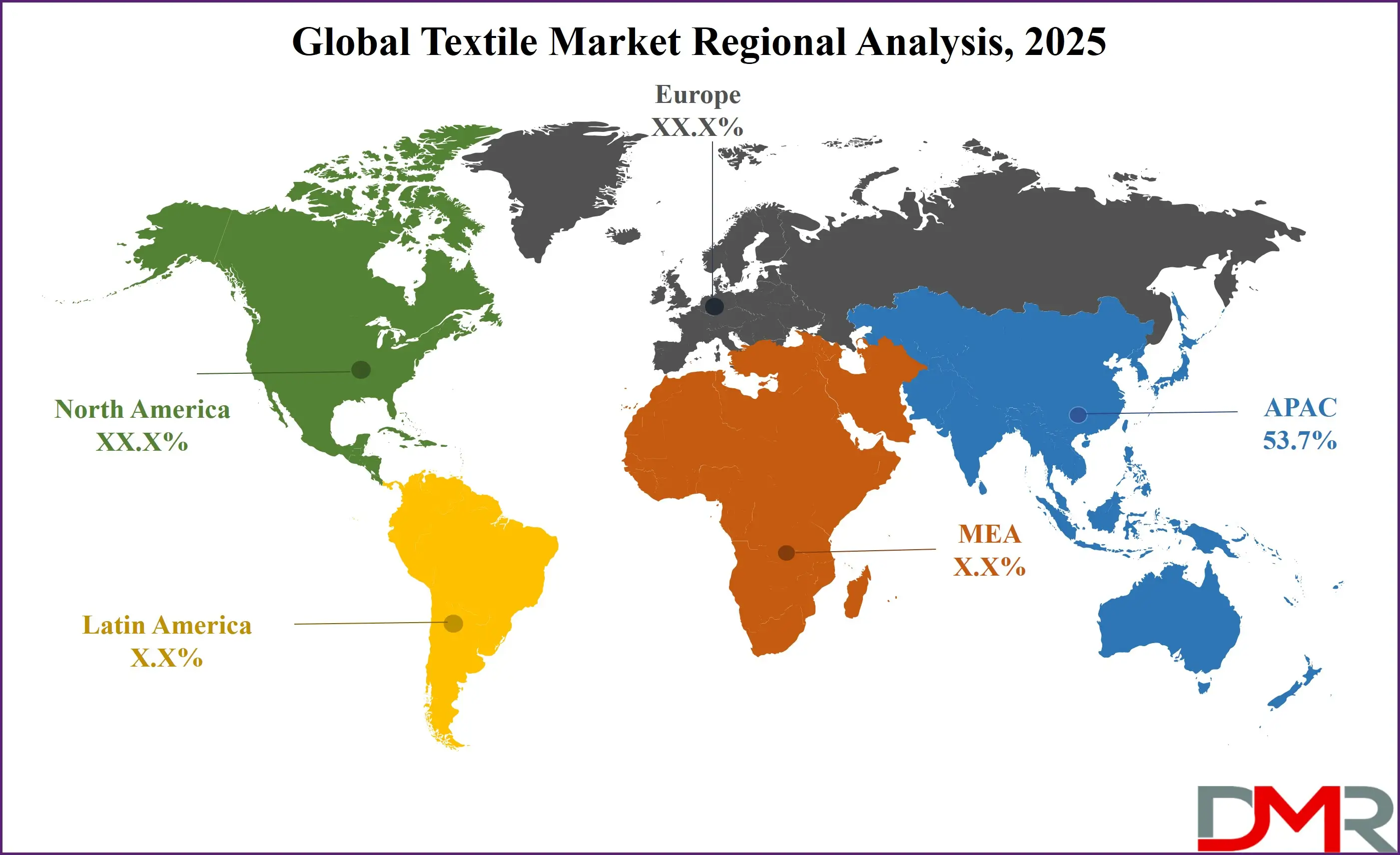
Its ability to produce everything from basic apparel to high-tech fabrics gives China an advantage. India with its rich textile history also plays a pivotal role. Both natural fibers like cotton and silk as well as handcrafted textiles made locally or handcrafted textiles produced internationally make an impactful statement about India as a textile powerhouse. Bangladesh and Vietnam have emerged as key garment manufacturing players due to cost-competitive, labor costs as well as trade agreements signed between major markets like the European Union and United States markets.
By Region
North America
Europe
- Germany
- The U.K.
- France
- Italy
- Russia
- Spain
- Benelux
- Nordic
- Rest of Europe
Asia-Pacific
- China
- Japan
- South Korea
- India
- ANZ
- ASEAN
- Rest of Asia-Pacific
Latin America
- Brazil
- Mexico
- Argentina
- Colombia
- Rest of Latin America
Middle East & Africa
- Saudi Arabia
- UAE
- South Africa
- Israel
- Egypt
- Rest of MEA
Global Textile Market: Competitive Landscape
Global textile markets feature a vibrant landscape of competition that spans from multinational corporations to small and medium-sized enterprises (SMEs). Asia-Pacific textile dominance lies in access to cost-effective labor, abundant raw materials, reliable supply chains, and advanced manufacturing capabilities.
The global textile market is highly competitive, featuring numerous key players operating across different regions using various strategies to maintain their positions. Furthermore, few dominant global brands play an outsized role within a fragmented yet dynamic marketplace. As one of the global textile market leaders, Arvind Limited stands out among others with major players like Vardhman Textiles, Indo Rama Synthetics, Loyal Textile Mills, Shandong Ruyi Technology Group, and Toray Industries being major players.
Each company specializes in manufacturing a wide range of fabrics, yarns, and technical textiles using vast supply chains that cater to global and regional demands for these textiles. In addition to traditional textile products, they also invest heavily in sustainable fabrics, recycled fibers, and smart textiles to adapt to changing consumer preferences and environmental standards.
Some of the prominent players in the Global Textile Market are
- BSL Limited
- INVISTA S.R.L.
- Lu Thai Textile Co., Ltd.
- Paramount Textile Limited
- Paulo de Oliveira, S.A.
- Successori REDA S.p.A.
- Shadong Jining Ruyi Woolen Textile Co. Ltd.
- Shandong Demian Incorporated Company
- Shijiazhuang Changshan Textile Co., Ltd
- Weiqiao Textile Company Limited
- DBL Group
- Other Key Players
Recent Developments
- October 2024: South Korea's Hansae Co. Ltd., a global fashion Original Design Manufacturer (ODM), acquired U.S.-based textile manufacturer Texollini. This strategic move aims to vertically integrate Hansae's operations and strengthen its portfolio in Central America. Texollini, founded in 1989, specializes in synthetic fibers and serves major clients including New Balance, Champion, Patagonia, and Alo Yoga.
- July 2024: Aizome, a health-focused textile company, introduced bed sheets free of synthetic chemicals, utilizing herbal dyes. This initiative was inspired by the founder's personal experience with the adverse effects of conventional textile dyes. Aizome's products emphasize safer, eco-friendly materials, aligning with the growing consumer demand for non-toxic textiles.
- April 2022: Pearl Global Industries Ltd., one of India's largest garment exporters, acquired a 52.11% equity stake in Bangladesh-based Alpha Clothing Ltd. for USD 1.05 million. This acquisition, funded through internal accruals, is expected to increase Pearl Global's production capacity by 8 million pieces per year and strengthen its manufacturing presence in the Bangladesh market.